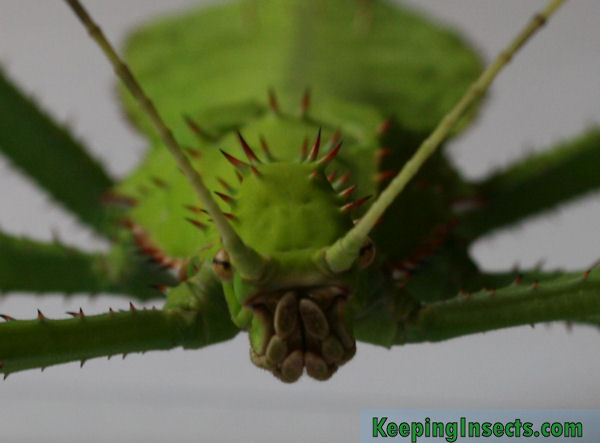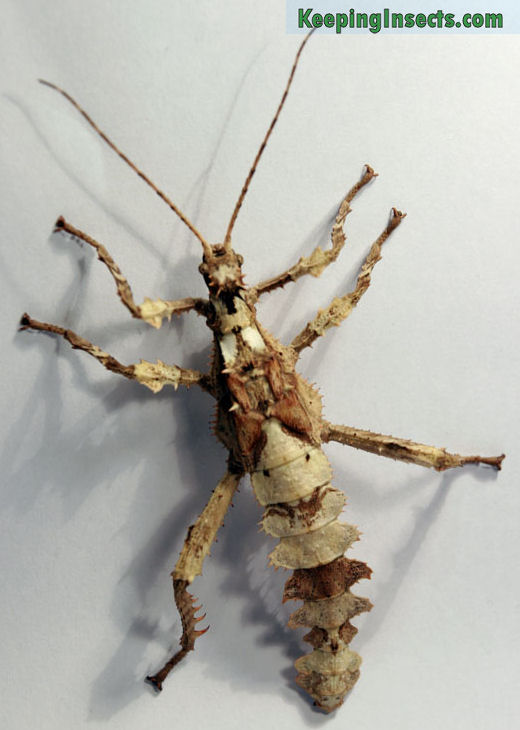The Jungle Nymph, or Heteropteryx dilatata, is the heaviest of all stick insects. It is very large, brightly green in color (females) and can live up to 2 years. The Phasmid Study Group gave this species the number PSG 18.
Heteropteryx dilatata occurs naturally in Malaysia.

A subadult female Jungle Nymph – Heteropteryx dilatata
Appearance of the Jungle Nymph stick insect
This species is not long and thin like people often expect from a stick insect. The males and females are totally different, they even seem a different species. The adult females are bright green, very large and have a very wide body. Their wings are really short and lay like a cap on the back of the insect. The males are long and slender and are brown with beige in color. Their wings are very long and extend all the way down its abdomen. Both sexes have small spikes on their head and body, but the female has more of them. The nymphs of both sexes are similar in color until about L7, they are brown with white-beige patches and the females become more beige-brown every molt while the males keep their patchy look. The hind wings of both sexes are pink to red, with the males also having black stripes (or kind of webbing) on these wings.
The females reach an length of 15 cm and are the second most heavy insect in the world (the first is a big beetle). The males 10 cm in length, quite light and able to fly.

An adult pair of Heteropteryx dilatata, the female is green and the male is brown.
Behavior of Heteropteryx dilatata stick insects
Generally this species is quiet during the day and active during the night. When threatened it will display a defense mechanism that can actually hurt you, therefore it is not suitable for children. When the female feels threatened, she will stand on her four front legs while keeping her hind legs and abdomen up in the air. If you touch it she will fiercely snap her hind legs together, which have very large spines on them. When you trap your hand or finger between these thorned legs, it can draw blood. The adult females will use their mini-wings to make a loud rustling noise when showing their defense behavior. All this display is meant to scare away predators.
This species is considered one of the most beautiful species of stick insect, since the female is so large and so beautifully brightly colored. This species lives and the longest of all stick insect species that are kept as pets, when cared for properly. They can live up to 2 years.

This is an subsubadult Jungle Nymph female.
Food for Jungle Nymphs
This species eats blackberry, raspberry, rose and ivy leaves. Do not feed it exclusively on ivy. Leaves of cut flowers or plants from stores are often sprayed with insecticide!

This is the mouth and face of a subadult female Jungle Nymph – Heteropteryx dilatata
Environmental conditions
The temperature can vary between 20 ° C and 30 ° C. Room temperature is fine for this species, but growth can be delayed if kept at low temperatures.
This species needs high air humidity. Spray at least five times a week to allow the insects to drink from the droplets and to keep the humidity up. Ventilation is very important, without enough of it Heteroperyx dilatata will get problems with mold and bacteria.
Like all species of stick insect, Heteropteryx dilatata needs an enclosure that is at least 3 times the length of the body in height, and at least 2x the length in width. For an adult female this means at least 45 cm in height and 30 cm in width. Larger is always better and is also necessary if you keep multiple individuals. At the bottom of the enclosure you need to place a layer of moist soil, sand or potting earth. The female lays her eggs in the soil with her ovipositor.

This is an subadult Jungle Nymph male – Heteropteryx dilatata.
Breeding and egg care
The difference between males and females is easy to see from an early nymphal stage. The females are beige / brown in color while the males are dark brown with beige segments in a regular pattern. A few molts before they mature, the female change from being beige to being bright green. She will stay like this all her life, while the male will never become green. When the male matures he will have long wings, the female will have only small wings that cannot be used to fly.
This species can only reproduce sexually, so one female will never produce offspring parthenogenicly. Breeding is simple, because you can house males and females together and they will mate when the time comes.
The eggs of Heteropteryx dilatata are oval dark grey balls which are deposited in the ground. Because the female lays her eggs in the soil, you always need to provide her with a box with a layer of soil. You can collect the eggs and put them in a separate box filled with damp soil. Keep the soil moist but do not allow mold to form.
This species is notorious for the long time it takes for the eggs to hatch. It may take between 12 and 14 months before an egg will hatch. That requires an awful lot of patience, because the eggs need to be kept moist for all this time. They can be incubated at the same temperature as the adults are kept, but development is faster at around 25 – 28 ° C.

A subadult female Jungle Nymph – Heteropteryx dilatata

